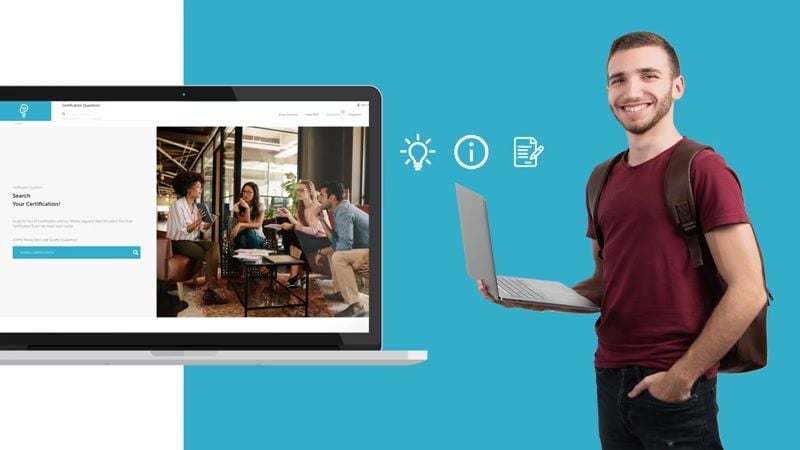Reading Time: 9 mins | Publish Date: 16 Nov 2025 | Update Date: 18 Jan 2026
How to Prepare For F5-201: TMOS Administration Exam
Preparation Guide for F5-201: TMOS Administration Exam
Introduction
An F5 Certified BIG-IP Administrator can manage application delivery networks (ADNs) and perform routine management and troubleshooting of F5 Traffic Management Operating System (TMOS) devices. Two exams are required to achieve the F5-CA certification:
- Exam 101 - Application Delivery Fundamentals
- Exam 201 - TMOS Administration
A F5 Certified BIG-IP Administrator manages preexisting BIG-IP installations and preliminary fault isolations. They must have the ability to make necessary configuration changes and modify BIG-IP objects. They are also responsible for application delivery networks (ADNs) and for conducting routine management and troubleshooting of F5 Traffic Management Operating System (TMOS) devices.
These Certified Experts use TMSH as well as a configuration utility to monitor BIG-IP resources such as virtual servers, pools, pool members, nodes, profiles and monitors. They also create, restore from and manage BIG-IP archives. Certified BIG-IP Administrators are further responsible for checking a resource’s status, availability and statistics, in order to understand how BIG-IP systems are currently processing traffic.
Administrators define the role of BIG-IP systems as a proxy device within an ADN. They set up, license and provision BIG-IP systems. A Certified BIG-IP Administrator uses profiles to control the way BIG-IP systems process traffic through virtual servers. They are also responsible for troubleshooting and determining problems using various diagnostic tools.
Passing this exam shows independence in performing day-to-day operations and basic troubleshooting of TMOS-based devices in various application environments after it has been installed, configured, and implemented. Individuals may choose to complete their certification journey here or move on to pursue the Technical Professional, Technical Specialist, Cloud, or Security Solutions certification tracks.
Introduction to F5-201: TMOS Administration Exam
The qualified candidate is capable of performing day-to-day operations of TMOS-based devices which have already been installed. They are also capable of basic troubleshooting of a TMOS-based device in order to provide full, accurate, and appropriate information to senior engineers and/or F5 Support.
They can do any of the following without assistance:
- Able to access and manage the BIG-IP through multiple paths (management IP, Self IP)
- Perform administrative tasks using the GUI
- Understand the relationship and differentiation between virtual servers, virtual server types, virtual addresses, pools, pool members, nodes, profiles, iRules, and address translation (NAT/SNAT)
- Be familiar with HTTP, ClientSSL, ServerSSL, TCP, UDP, and persistence profiles
- Open a support case and utilize online resources such as AskF5, F5 iHealth, and DevCentral
- Perform software management functions on the platform (for example, capable of performing upgrades and licensing).
Certification Path
F5 201 is the second exam. Successful completion by candidates will allow them to achieve F5 Certified! Administrator, BIG IP status.
Understanding of functional and technical aspects of Troubleshooting Basic Virtual Server Connectivity Issues
The following will be discussed in this section:
- Understand how a packet is processed once it arrives at device (connection table, packet filters, etc.)
- Understand how a virtual server processes a request (most specific to least specific)
- Given a specific connectivity issue, isolate where the problem might be according to the processing order
- Determine the state of a virtual server (offline, enabled, etc.)
- Determine if a virtual server is configured for the proper listening port
- Determine if a virtual server is configured with the proper IP address configuration
- Determine if the virtual server is configured with the appropriate profiles
- Determine if the pool configuration has an effect on virtual server state
- Determine which tools to use in order to diagnose the issue
- Understand the difference between the virtual servers status definitions
- Understand the effects of health monitors on the status of pool members/nodes
- Determine the state and availability of the pool member/node in question
- Verify the pool member/node Ratio configuration
- Verify the pool member/node connection configuration and count
- Explain the concept of “persistence”
- Verify the type of persistence profile assigned to the virtual server in question
- Validate the expected persistence behavior
- Differentiate between fallback and primary persistence
- Use the appropriate tool to troubleshoot persistence
Understanding of functional and technical aspects of Troubleshooting basic hardware issues
The following will be discussed in this section:
- How to reboot an F5 platform into the EUD
- How to download output from the unit an EUD was run on
- How to interpret the output from an EUD and determine if the test passed or failed
- How to locate the LCD on an F5 Platform
- How to correlate the LCD message to message in the corresponding log file
- How to identify which tasks the buttons on the LCD perform
- Indicate which logs would contain debugging information
- Given a log file, determine the nature of a hardware issue
- Given a possible issue, determine which log file entries to review
- Understand the relationship between interfaces, trunks, VLANs and their status/statistics
Understanding of functional and technical aspects of Troubleshooting basic performance issues
The following will be discussed in this section:
- Recognize when a packet capture is needed within the context of a performance issue
- Use BIG-IP tools in order to identify potential performance issues
- Differentiate between performance issue types (i.e. Latency, Congestion, broken content)
- Establish the frequency of a given issue (random, continuous, isolated, intermittent, repetitive intervals)
- Understand how to get performance statistics in addition to the those shown in the dashboard (Overview - Performance)
Understanding of functional and technical aspects of Troubleshooting basic device management connectivity issues
The following will be discussed in this section:
- Isolate potential causes of basic network connectivity issues, given scenarios related to: client configuration, client network access, device network access, network topologies
- Apply connectivity troubleshooting tools (i.e. ping, traceroute, http/https availability, remote shell access, network based console access) in the appropriate situation
- Check and interpret port lockdown settings and packet filters in order to determine the cause of a management connectivity issue to a Self-IP
- Given the use of a remote authentication server, verify proper DNS and NTP settings in order to diagnose a connectivity issue
- Determine whether a filter is enabled
- Interpret a packet filter rule list in a given situation
Understanding of functional and technical aspects of Opening a support ticket with F5
The following will be discussed in this section:
- Identify the appropriate supporting components and severity levels for an F5 support ticket
- Identify the necessary components for all support cases (Qkview uploaded to iHealth/ or attached to case, serial number of device, problem description, other supporting data)
- Identify severity levels and the associated response times
- Given an issue, determine the appropriate severity according to F5 guidelines
- Provide quantitative and relevant information appropriate for a given issue
- Distinguish between qualitative/quantitative statements in order to assemble an accurate problem description
- Distinguish between relevant/irrelevant information in order to assemble an accurate problem description
- Review the Network Map in order to determine the status of objects
- Explain the status icons of objects on the map
- Explain what virtual servers, pools, nodes and pool members are
- Use the dashboard to gauge the current running status of the system
- Interpret each of the statistic types displayed by the dashboard
- Given a situation, predict the appropriate dashboard statistics
- Review log files and identify possible events
- Given log file snippets, describe an event sequence
- Given log file snippets, identify critical events
- Use iApps Analytics to gauge the current running status of application services
- Explain the purpose of iApps Analytics
- Describe how to capture application statistics
- Given a current running status, recognize significant statistics
Understanding of functional and technical aspects of Maintaining system configuration
The following will be discussed in this section:
- Create and restore a UCS archive under the appropriate circumstances
- Discuss scenarios in which restoring a UCS archive is appropriate
- Discuss the tasks involved in successfully restoring a UCS archive
- Given a scenario, discuss when it is appropriate to create a UCS archive
- Identify which high-level tasks can be automated using BIG-IQ
- Manage software images
- Given an HA pair, describe the appropriate strategy for deploying a new software image
- Understand the processes of licensing, license reactivation, and license modification (add-ons)
- Identify which modules are licensed and/or provisioned U/A
- Explain how to create a user U/A
- Explain how to modify user properties
- Given a proposed virtual server configuration change, outline the scope of the change and for which connections those changes will affect (active connections, new connections, persisted sessions)
- Given a description of an application, identify the correct virtual server configured for it (HTTP/HTTPS, TCP/UDP, VLANsenabled, route-domain)
- Given a situation where a virtual server configuration change did not appear to immediately take effect, determine why
- Distinguish between disabling a member and forcing it down
- Determine use cases for disabling a member
- Determine use cases for forcing down a member
- Given a situation where a pool member has been disabled but still appears to be receiving traffic, determine the cause
- Articulate the characteristics of a pool member that has been disabled or forced offline (Such as for new connections, persisted connections, etc.)
Who should take the F5-201: TMOS Administration Exam
People who are interested in getting a F5 Professional Certification which validates your expertise in manipulating the entire application stack - from traditional network knowledge all the way to advanced application-layer understanding, with the ability to integrate those two worlds. Candidates should have a basic understanding of network fundamentals, protocols, and common traffic management concepts. The student should also understand the basic concepts of F5 technology as applied to network fundamentals, protocols, and traffic management.
Candidates should have the following knowledge/capabilities:
- Articulate the advantages of a full application proxy.
- Explain the seven layers of the Open Systems Interconnection (OSI) model.
- Describe valid uses/methods of HTTP.
- Identify and define the components of TMOS (F5 Traffic Management Operating System).
How much F5-201: TMOS Administration Exam Cost and Details
Examination Name F5 101: Application Delivery Fundamentals Passing Score: 245 or higher Length of Exam: 90 min Types of questions: Multiple Choice Questions No. of Questions: 80 Questions Examination Fees: $180 USD
How to book the F5-201: TMOS Administration Exam
Register or log in on F5 Network website, or visit the Candidate Portal, or contact F5 Certification for more information.
Average Salary of F5-201: TMOS Administration Exam Certified Professionals
The average salary of a AI-900: Microsoft Azure AI Fundamentals Exam Outlook and Modules Exam Certified Expert in:
- United State - 108,682 USD
- India - 9,71,117 INR
- Europe - 97,440 EURO
- England - 61,267 POUND
The benefit of obtaining the F5-201: TMOS Administration Exam Certification
If you work with F5 on a daily basis you are well aware there is more to becoming an F5 expert than memorizing commands and configuring BIG-IP modules. True application delivery administrators / engineers know you need skills ranging from networking, server administration, security, to development.
Difficulty in Attempting F5-201: TMOS Administration Exam
If the user has successfully passed the F5-201 practice exam and has been through F5-201 dumps then the certification exam will not be too much difficult as the user has shown aptitude for understanding complicated processes.

